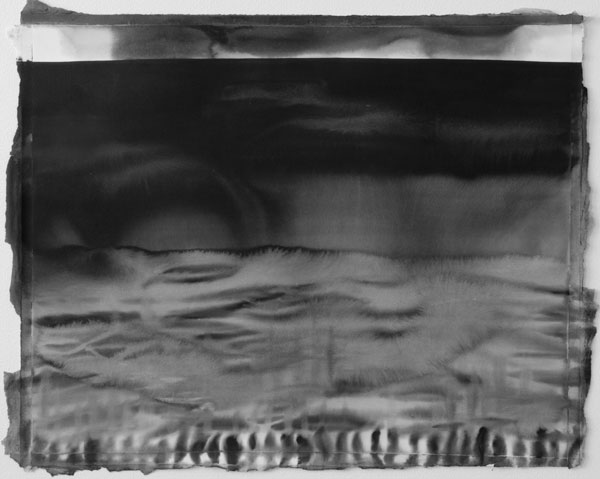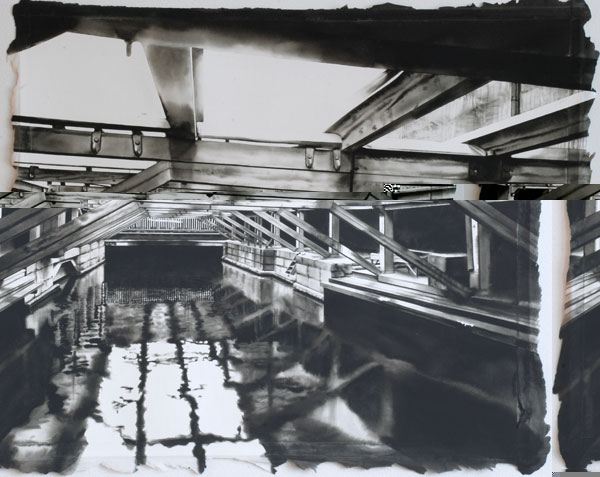




watercolour on paper,
62 x 78 cm,
attached on steel wires


Within Cuts and Bends
The Swedish artist Kristina Bength reactivates and translates past events into paintings and
drawings. She reveals the possibility of distorting history and memory and replaying the
present. At L MD galerie, Kristina Bength shows the project Within Cuts and Bends, presented partly
during « Le Salon du Dessin Contemporain » at Carrousel du Louvre in March. Within Cuts
and Bends departs from photographic archive material that comes from the photographer,
actress and impostress Amanda Kristina Pedersen, who in 1904 was convicted of fraud and
forgery in Falun, Kristina Bength’s hometown.
Since 2008 Kristina Bength has approached the life and destiny of Amanda Kristina Pedersen by bringing the game of fraud and imposture into play in several ways. How this play is at work in Within Cuts and Bends is not explicitly pronounced; it could however be presumed that Kristina Bength works as a director that interprets the manuscript of which Amanda Kristina Pedersen is the author, and Pedersen guides Bength into new projects.
Departing from Amanda Kristina Pedersen’s life and art of forgery, Bength creates and installs a slide of watercolour paintings that resembles an immovable silent film telling a story in fragments at the point where photographic realism meets the flowing motion of the aquarelle. The paintings depict spaces empty of human presence, and they both invite and exclude the spectator from entering these spaces. Mute surfaces that keep the gaze out are alternated with surfaces that move freely and provoke forms that heavily contrast with photography. In other words, the aquarelle paintings give dominant significance to how the water’s fluid, transformative quality conquers and challenges the static time of photography.
In terms of material and technique as well as content, water plays an important part of Within Cuts and Bends. Being both a means of the painting process and a motif alluded upon, water signifies the attempt to trace histories/stories and give new form to them by changing them. In this sense water becomes a metaphor of recollection and oblivion, referring back to the overall question of what it means to remember and forget, but also to what it means to use archive material and restage it in new stories. The difficulties and pitfalls of returning to the past and rewrite history is the main theme of Kristina Bength’s art. The events as such cannot return, but they can recur in other forms if painting succeeds to put the storytelling potential of the archive into use.
As already mentioned, Within Cuts and Bends alludes on cinema and the cinematographic apparatus, and the form of the installation resembles a film strip. In cinema, the cinematic form is conditioned by cuts between frames, and its narrative could be said to be the conjunction of different elements layered in movement. Here, the cinematic movement is on the one hand put to rest in the sculpture of the installation, on the other the stillness of photography is put in motion by the process of the painting and the fleeting time of water.
Within Cuts and Bends tries to move and find itself within the cinematic apparatus giving birth to new narratives somewhere where painting intersect with photography and photography with cinema. Even better, it could be said that Within Cuts and Bends tries to investigate into the tension between painting and photography by moving within the mechanical, analogous apparatus of cinema. The installation’s sculptural form establishes an allegorical relation to cinema, and there is also something mechanical over the installation. The paintings creates a separate form and are attached to steel wires that outline their own geometry of lines and forms in the exhibition space, and the installation gives the impression of being a construction that has suddenly stopped, lost its motion and been abandoned, quite similar to the milieus that the series of paintings are showing.
Another dimension of Bength’s installation is the tense meeting between the metallic firmness of the wires and the fragility of the aquarelle paintings’ paper and tape. This tension is also emphasized in the paintings.















